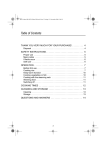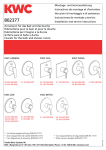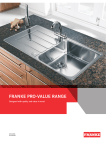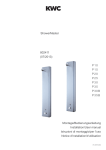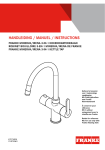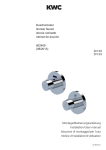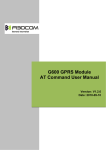Download Franke TP-125B
Transcript
FOOD WASTE DISPOSER FRANKE TURBO PLUS OWNERS GUIDE Important - Read all instructions thoroughly Important Safety Instructions Instructions pertaining to risk of fire, electric shock or injury to persons. Save these instructions. WARNING - When using electrical appliances, basic precautions should always be followed, including the following: 1. Read all instructions before using the appliance. 8. Additionally for continuous feed models: 2.To reduce the risk of injury, close supervision is necessary when an appliance is used near children. -C are must be taken to ensure that the supply is disconnected by switching off the electric supply or by removing the plug from the socket-outlet before freeing a jammed rotor. -W hen not operating the disposer, leave the stopper in place to reduce the risk of objects falling into the disposer. 3.Do not put fingers or hands into a waste disposer while it is functioning. 4.Turn the power switch to the off position before attempting to clear a jam or remove an object from the disposer. 5.When attempting to loosen a jam in a waste disposer, use a long wooden utensil e.g. spoon. 6.When attempting to remove objects from a disposer, use long-handled tongs or pliers. 7. To reduce the risk of injury please note: - this disposer is not for grinding hard materials, such as glass and metal; - this disposer must be connected to the electric supply by means of either a power supply cord or insulated wires in a flexible conduit; - when installing the disposer, care must be taken to ensure that the reset button of the overload protection device remains readily accessible. - Do not operate disposer unless splash guard is in place. 9. For proper electrical earth instructions see the ELECTRICAL CONNECTION details of this manual. 10. All installations should be carried out by a qualified electrician. 11.The symbol on the product or on its packaging indicates that this product may not be treated as household waste. Instead, it shall be handed over to the applicable environmental collection point for the recycling of electrical and electronic equipment. For more detailed information about recycling of this product, please contact your local authority, your household waste disposal service or the shop where you purchased the product. Please retain for future reference www.franke.co.uk 1. OVERFLOW/APPLIANCE CONNECTIONS 2B * AIR GAP 1B For overflow or dishwasher connections, complete the following procedure. Alternatively go on to section 3. KNOCK 2A OUT PLUG 1 Using a blunt instrument (steel punch or wooden dowel), knock out entire plug (see 1A). Do not use a screwdriver or sharp instrument. (When knockout plug falls into Disposer, you may remove it or grind it up when the disposer is used. This will not damage the disposer in any way, but may take some time to grind over the course of several uses). RUBBER HOSE DISHWASHER 2B GAP HOSE * AIR WOOD OR METAL DOWEL DRAIN 2A KNOCK 1A OUT PLUG 2 Connect dishwasher hose (see 1B) using a hose clamp. Make sure all plumbing connections are tight and in accordance with all plumbing codes and ordinances. Run water and check for leaks. DISPOSER RUBBER HOSE *Air gap may not be required DISHWASHER for all installations.HOSE Check local plumbing codes. WOOD OR METAL DOWEL DRAIN DISPOSER When you do NOT wish to utilise the Air Switch *Air gap may not be required for all installations. Check local plumbing codes. (e.g. if hard wiring the WDU to a standard electrical switch) Follow the following procedure: 1 With the disposer mounted on the sink and the unit connected to the mains, turn ON the wall mounted switch. 4 With the disposer ON pull air switch hose from disposer connection and discard air switch actuator and hose. 2 Connect the air switch tube to the nipple on the underside of the unit. 5 Turn the disposer OFF by turning off the switch, usually controlled by a wall mounted switch. 3 If the disposer is OFF, depress air switch actuator to turn the disposer ON. 6 Operation of disposer is now controlled in a typical manner by the wall mounted switch. 253 136 218 193 TP-75 Continuous Feed TP-125 Continuous Feed 330 136 253 136 136 TP-50 Continuous Feed 330 295 270 356 381 416 491 FRanke turbo plus models TP-125B Batch Feed 2a. INSTALLATION OF 3-BOLT MOUNTING ASSEMBLY For TP-50, TP-75 and TP-125 models. Read completely before starting NB - Pay close attention to the order of mount assembly parts, as they have been correctly assembled by the factory. (See A and B.) 3-Bolt Mount System SINK FLANGE ADisassemble the mounting assembly, as it has been shipped, by turning the sink flange until the projections align with the notches in the mount ring and allow you to pull the sink flange up and out of the remaining mount assembly. Note the sequence of these parts as they are stacked and refer to A and B to identify each part. Unpack the 3 mount screws and screw them half way through the mount ring (notice “THIS SIDE UP” is imprinted on top of the mount ring). Next, stack the rubber gasket on top of the protector ring and sit them on top of the pointed ends of the mount screws. BKeep these assembled parts together and set aside. Before you connect the disposer to the mount assembly under the sink, you may want to practice engaging the groove of the cushion ring to the ridge at the bottom of the sink flange (see A and read Sec. 5). CBe sure your sink is clean. Pack the underside rim of the sink flange with plumber’s putty (see C). Position the sink flange so it is centered and readable as you look into your sink. Push the sink flange firmly into the sink opening to make a good seal. DO NOT move or rotate the sink flange once seated or the seal may be broken. DTake the remaining portion of the mount assembly, as it was set aside and make sure that the rubber gasket is on top of the 3A SINKholding the sink protector ring. From under the sink, while flange firmly with one hand, line up the notches in the mount STOPPER* ring with the projections of the sink flange. Slide the mount assembly up onto the sink flange, past the projections and SINK FLANGE** give the mount assemblyPLUMBER’S a 1/4 turn, so that it will hang by PROJECTIONS PUTTY itself (see D). SINK FLANGE GASKET PROTECTOR RING MOUNTING SCREWS (3) SINK MOUNT RING 3A B SINK STOPPER* SINK FLANGE** PLUMBER’S PUTTY PROJECTIONS RIDGE RUBBER SINK FLANGE GASKET** PROTECTOR RING** MOUNTING SCREWS** MOUNT RING** SCREW CLAMP** CUSHION RING** RIDGE DISHWASHER DISCHARGE INLET HOPPER SCREWS RIDGE ELBOW FLANGE ETighten the 3 mounting screws evenly with a screwdriver RUBBER SINK FLANGE GASKET** (see E). DO NOT OVERTIGHTEN! Trim off excess putty. PROTECTOR RING** MOUNTING SCREWS** Mount Assembly MOUNT RING** SCREW CLAMP** RIDGE PROTECTOR RING SCREW CLAMP A 3B CUSHION RING** SINK FLANGE HOPPER PROTECTOR RING DISHWASHER DISCHARGE INLET SCREWS RUBBERELBOW FLANGE GASKET ELBOW GASKET END BELL (ELECTRICAL CONNECTIONS) END BELL (ELECTRICALMount Assembly CONNECTIONS) ELBOW GASKET SINK FLANGE DISCHARGE ELBOW 3B SERIAL #- RECORD RUBBER ON WARRANTY GASKET CARD SCREW CLAMPStopper looks different than the stopper MOUNTING * Batch Feed illustrated. SCREWS ** Mount Assembly (see 2B) CUSHION RING DISCHARGE ELBOW MOUNTING RING MOUNTING SCREWS SERIAL #- RECORD ON WARRANTY CARD MOUNTING Feed Stopper looksRING different than the stopper illustrated. CUSHION RING*** Batch Mount Assembly (see 2B) 3C 3D C 3C 3E D3D E3E 2b. INSTALLATION OF EZ MOUNT ASSEMBLY For TP-125B models. Read completely before starting ARaise the mount ring towards the top of the sink flange. Remove cushion mount. Remove mount ring. You may want to practice installing the cushion mount at this point before you are under the sink See the ‘Important Notice: Cushion Mount Detail’ below. BUnscrew support ring from the sink flange and remove fibre gasket. You are now left with sink flange and rubber gasket. CThe rubber gasket is used instead of plumbers putty with stainless steel sinks. Others sinks will require silisone or plumbers putty. DIf no caulking nis used, insert sink flange through rubber gasket into sink opening. Do not rotate sink flange once it is seated. A EIf you use silicone instead of the gasket, form a ring around the underside of the sink flange (see C). Insert flange into sink opening, press down hard to squeeze out excess (see B). From under the sink, clean up excess flush with bottom edge of the sink opening. B FFrom underneath sink, slip fibre gasket onto exposed sink flange. With arrows pointing up, screw support ring onto the sink flange and hand tighten until the sink flange will not move. At this point you may want to insert stopper in sink and fill water to check sink flange seal and ensure there are no leaks. GPlace mount ring over sink flange and hold in place while installing cushion mount (large side down) so the groove on the inside of the cushion mount fits over the lip on sink flange (see D). HThe disposer must be installed so that the reset button in easily accessible. IMPORTANT NOTICE: Cushion Mount Detail When the cushion mount is installed correctly, the lip of the sink flange fits into the groove of the inside of the cushion mount and the mount ring can be pulled downwards over the cushion mount and will be free to rotate. The bottom bead of the cushion mount acts as a gasket between the bottom of the sink flange and the top of the disposer (see F). CONNECTION OF AIR SWITCH TO UNIT: C To install the button switch unscrew the tightening nut and thread plastic pipe and base of button switch through hole in sink/work top. Attach nut and tighten up nut on base of button switch. Push in plastic pipe in to the nipple on the base of the unit. E F D 3. ELECTRICAL CONNECTIONS DANGER - improper connection of the equipment grounding conductor can result in a risk of electric shock. Check with a qualified electrician or serviceman if you are in doubt as to whether the appliance is properly grounded. Do not modify the plug provided with the appliance if it will not fit the outlet. Have a proper outlet installed by a qualified electrician. Grounding Instructions For waste disposers equipped with a grounded plug-in power cord. This appliance must be grounded. In the event of a malfunction or breakdown, grounding provides a path of least resistance for electric current to reduce the risk of electric shock. This appliance is equipped with a cord having an equipment-grounding conductor and a grounding plug. The plug must be plugged into an appropriate outlet that is properly installed and grounded in accordance with all local codes and ordinances. If the supply cord is damaged it must be replaced by the manufacturer, its service agent or similarly qualified person in order to avoid a hazard. 4. ATTACHING DISCHARGE ELBOW Assemble rubber gasket to waste elbow (see 4A). Connect waste elbow to the disposer (see 4B), proceed to step 5 and then connect bottom of the elbow by tightening the slip nut (see 4C). 4A 5A 4B If you are connecting to a dishwasher, return to section 1B. If not, make sure all plumbing connections are tight and in accordance with all plumbing codes and ordinances. Run water and check for leaks. 4C 5B 5C 5a. 3 bolt MOUNT ASSEMBLY For TP-50, TP-75 and TP-125 models. Important PLEASE READ - DO NOT REMOVE CLAMP FROM CUSHION RING OR CUSHION RING FROM HOPPER. BOTH PARTS ARE FACTORY INSTALLED AND INSTALLATION READY A Press firmly around the cushion ring to ensure it is engaged with the neck of the disposer. B Lubricate the top inside lip of the rubber cushion ring with a liquid soap. C Line up discharge elbow of disposer with trap under mounting assembly (see 5A). Guide disposer up and engage the GROOVE 5A 6A 6A of the cushion ring around the RIDGE at the bottom of the sink flange (see 5A & refer back to 2B). While still supporting the disposer, tighten the screw-clamp around cushion ring. The disposer will now hang by itself. D If you need to turn the disposer make sure the sink flange does not turn. It will break the seal created when installed. 6B 5B 6B SINK SINKFLANGE FLANGE SINK SINKFLANGE FLANGE GROOVE GROOVE SINK SINKFLANGE FLANGE CUSHION CUSHIONRING RING TOP TOPANGLED ANGLEDSURFACE SURFACE CLAMP CLAMP CLAMP CLAMP CUSHION CUSHION RING RING HOPPER HOPPER 5b. E Z MOUNT ASSEMBLY For TP-125B models. SLOT A Line up disposer under mounting assembly. Guide hopper projections into mount ring slots. Turn mount ring about 1/4” to right so that disposer is temporarily supported (see 6A). B Turn mount ring and disposer until disposer elbow lines up with trap (see 6B). C Turn mount ring to the right (counter-clockwise)until it locks up tight. Tap the mount ring ears with a hammer until the lock position is achieved. Hopper projections must be to extreme left of mounting slots (see 6C & 6D). D If mount ring is hard to turn, you may add a small amount of petroleum jelly or liquid soap to hopper projections. Run water and check for leaks. SLOT HOPPER HOPPER 6A 6B 6A 6B PROJECTION ELBOW PROJECTION TRAP ELBOW 6C TRAP LOCKING DETAIL 6C “SUPPORTED” POSITION LOCKING DETAIL 6D HOPPER PROJECTION IN 6D HOPPER PROJECTION IN “SUPPORTED” POSITION HOPPER PROJECTION IN “LOCK” POSITION MOUNT RING HOPPER PROJECTION IN “LOCK” POSITION MOUNT RING 6a. CONTINUOUS FEED OPERATING INSTRUCTIONS The Anti-Jam Swivel Impellers make a clicking sound as they swing into place. This indicates normal operation. A Remove sink stopper. Turn on a medium flow of cold water. B Turn switch to ON position; your motor is turning at full speed and ready to use. C Scrape in food waste. Down the drain go table scraps, peelings, rinds, seeds, pits, small bones and coffee grounds. To speed up food waste disposal, cut or break up large bones, rinds and cobs. Large bones and fibrous husks require considerable grinding time and are more easily thrown away with other trash. Do not be alarmed that the disposer slows down while grinding. The disposer is actually increasing torque (grinding power) and is operating under normal conditions. D Before turning disposer off, let water and disposer run for approximately 15 seconds after shredding stops. This ensures that all waste is thoroughly flushed through trap and drain. E It is not recommended to use hot water while running disposer. Cold water will keep waste A and fats solid so disposer can flush away particles. 6B. BATCH FEED OPERATING INSTRUCTIONS The Anti-Jam Swivel Impellers make a clicking sound as they swing into place. This indicates normal operation. A water. A Remove sink stopper and turn on a medium flow of cold B Scrape in food waste. Down the drain go table scraps, vegetable peelings, cobs, rinds, pits, bones and coffee grounds. (see A) C Insert stopper to start disposer. (see B) One of the two small slots in stopper base must line up with switch plunger inside the neck of the disposer. Push down firmly to turn the disposer on. Lift stopper to shut the disposer off. B D Run disposer for 15 seconds after shredding stops. This ensures that all waste is thoroughly flushed through the drain. E To fill sink, insert stopper and align the largest slot with the switch plunger. (see C) Push down to seal sink without starting the disposer. When medium sized slot (see B) in stopper base is lined up with the switch plunger, water can MEDIUM SMALL SLOT SLOT drain, but tableware, etc., cannot be accidentally dropped into disposer. C B A MEDIUM SLOT B C 7. TIPS FOR SUCCESSFUL OPERATION ABe sure disposer is empty before using your dishwasher so it MEDIUM SMALL may drain properly. SLOT SLOT B You may want to leave the stopper in the drain whenLARGE not in SLOT use to prevent utensils and foreign objects from falling into the disposer. C C Your disposer is ruggedly built to give you many years of trouble free service. It will handle all normal food wastes, but it will NOT grind or dispose of such items as plastic, tin cans, bottle caps, glass, china, leather, cloth, rubber, string, clam and oyster shells, aluminum foil or feathers. LARGE SLOT SMALL SLOT LARGE SLOT 8. TROUBLESHOOTING Before seeking repair or replacement, we recommend that you review the following: SAFETY NOTE: Before investigating you must disconnect the power supply. Depending on the installation this can be done by either removing the plug from the socket or for continuous feed models, switching the disposer control to OFF. LOUD NOISES: (Other than those during grinding of bones and fruit pits) These are usually caused by accidental entry of a spoon, bottle cap or other foreign object. To correct this, remove *splash guard and remove object with long handled tongs. Replace *splash guard. UNIT DOES NOT START: With *splash guard removed, check to see if turntable will rotate freely using a wooden utensil. If turntable rotates freely, replace *splash guard and check reset button to see if it has been tripped. Reset button is red and located opposite discharge elbow, near the bottom (see 8A). Push button in until it clicks and remains depressed. If reset button has not been tripped, check for shorted or broken wire connecting to disposer. Check electrical power switch, fuse box or circuit breaker. If wiring and electrical components are intact, the unit may have internal problems that require service or replacement. IF TURNTABLE DOES NOT ROTATE FREELY: Check for foreign object lodged between the turntable and grind ring. Dislodge object by rotating table with a wooden utensil and remove object (see 8B). If no foreign object is present, there may be internal problems. CONNECTION OF AIR SWITCH TO UNIT: To connect the air switch the tube should be connect to the nipple on the underside of the unit by pushing it on firmly. Franke UK Limited West Park, MIOC Styal Road Manchester M22 5WB Phone +44 (0)161 436 6280 Fax +44 (0)161 436 2180 [email protected] www.franke.co.uk Service & Spares UK Mainland & N. Ireland Tel: 0844 371 0195 Fax: 0844 371 0198 [email protected] Republic of Ireland Tel: +353 1 413 6481 Fax: +353 1 413 6489 [email protected] LEAKS: If the unit leaks at the top, it may be due to: 1.Improper seating of sink flange (gasket choice, putty or tightening.) 2. Support ring not tightened properly. 3. Defective cushion mount. If unit leaks at the waste elbow, leak may be due to improper tightening of elbow flange screws. 8A 7A 8B RESET BUTTON REMOVE SPLASH GUARD TURNTABLE SERIAL NO. WARNING: Before resetting, disconnect the power supply please see SAFETY NOTE above. The overload control prevents the motor from operating should overloading occur. This safety feature protects your house wiring and your disposer. When overloaded, the motor will stop automatically. *Splash guard is not used with Batch Feed or 3-Bolt Mount units.








